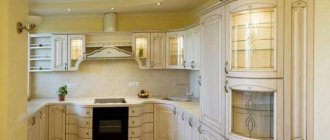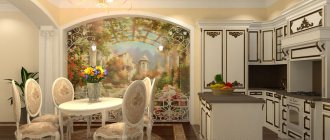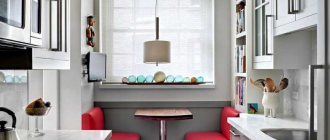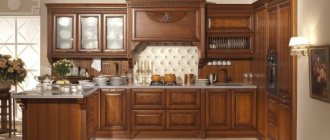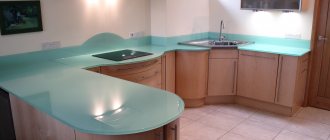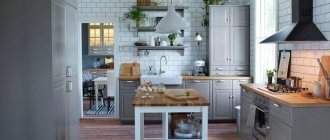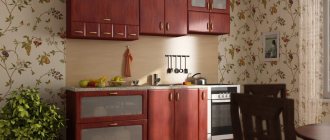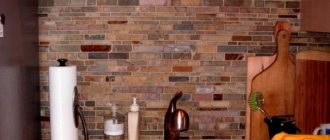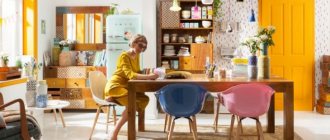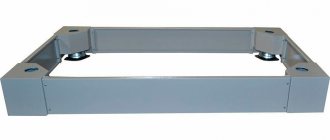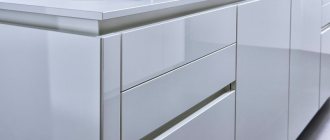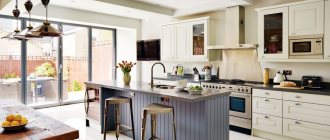Consumers tend to be wary of anything new. This feature of perception also affected plastic kitchens. But soon buyers appreciated all the advantages of the material.
In the photo: plastic kitchens can be of almost any color
Many people think that plastic kitchens are made entirely of plastic (this illusion is often created in the photo). But this is nonsense: kitchen furniture cannot be made exclusively from plastic. This material is used only for cladding facades.
Types of plastic kitchens
Furniture, which is commonly called plastic, is actually a set with facades lined with plastic. There are two types of kitchens on the market:
- with MDF facades covered with plastic (one of the more expensive furniture options);
- with plastic-coated chipboard facades (a budget option for a plastic kitchen).
There are several options for processing the ends:
- aluminum profile edging;
- postforming (layering plastic on two ends and gluing PVC edges on the two remaining ends);
- gluing with acrylic or PVC edges (reviews say that acrylic is more practical).
Edges allow you to experiment with color. You can create doors with ends whose color will differ from the main panel. This opens up space for imagination.
A PVC edge can become a bright accent, repeating the color of the tabletop, textiles or apron, and can also be combined with other interior details, as in the photo below.
In the photo - a plastic kitchen with a white PVC edge
• Unusual textures
| 225/Mandarin Brass | 260/Mandarin Quartz | 226/Mandarin Copper | 5906/Crystaline Black Star |
| 571/L Carbon black | 579/L Carbon gray | 5903/Crystaline White Star | 5904/Crystaline Black diamond |
| 425/MG-2 Purple Heather | 428/MG-2 Electric Blue | 441/MG-2 Green lemon | 5901/Crystaline White diamond |
| 460/MG-2 Young grass | 463/MG-2 Yellow Apple | 835/MG-2 Orange | 484/MG-2 Blue sapphire |
| 469/MG-2 Yellow Africa | 423/MG-2 Violet Madras | 406/Longline White Spring | 1030/Fiber Yellow |
| 1032/Fiber Green | 1091/Fiber Beige | 406/CRYSTAL White spring Kaleidos | 406/LENS White Spring Kaleidos |
| 421/Lens Black Kaleidos | 421/Shards Black Kaleidos | 879/LENS Graphite gray | 879/SHARDS Graphite gray |
| 421/Crystal Black Kaleidos | 406/SHARDS White Spring Kaleidos | 2597/MB Golden ball | 2598/MB Silver ball |
| 2608/MB Blue ball | 2609/MB Green ball | 2634/MGL Silver grill | 2635/MGL Golden grill |
| 2620/MGL Blue grill | 2622/MGL Green grill | 2614/MB Douglas light | 2616/MB Douglas dark |
| 880/L Silver | 877/MD Aluminum | 881/L Gold | 2618/MB Forest bark |
| 873/ST Brushed aluminum | 874/ST Brushed brass | 744/MTD MetDecor | 745/MTD MetDecor |
| 746/MTD MetDecor | 747/MTD MetDecor | 877/MP Aluminum | 726/L Mirror anthracite |
| 2822/LongLine Soffione cedro | 2835/LongLine Soffione bianco | 2824/LongLine Fiori rose | 2826/LongLine Fiori verde |
| 2829/LongLine Brocade | 2832/LongLine Ivy | 1260/L Stardust | 243/L Gray wave |
| 2701/SL Silver | 2702/SL Silver Universe | 2708/Drops Oriental gold | 2705/SL Silver oriental |
| 244/L Mother of pearl red | 251/L Pearl beige | 265/L Gray |
Technological features
The technology for the production of plastic facades involves gluing chipboard or wood-fiber boards with thin plastic under a press. The edges of the canvases are glued on an edgebanding machine.
Plastic for facades comes in different types:
- medium and cold pressure roll plastic (CPL);
- high pressure cladding plastic sheet (HPL).
The color scheme is varied. These can be bright monochromatic or delicate pastel facades; doors imitating wood, stone, leather or fabric, with a pattern in the form of drops of water, leaves, fruit, grass. Entire paintings can be applied to plastic.
An interesting new product is acrylic-based plastic. This material looks impressive. All beauty is associated with the pattern, combining a matte background and glossy patterns or vice versa. The photo below shows samples of plastic facades.
And this is not the entire color palette
HPL plastic for facades
The price of sheet laminate is higher than that of rolls, but the quality of the facades will be impressive. The material is rigid and hard sheets that hold their shape well and have excellent technological characteristics. They are labeled as HPL (high pressure laminate). This is an environmentally friendly material. Consumer reviews about it are positive.
In the photo: HPL plastic looks pretty nice on the headset
Sheet plastic is produced by pressing special grades of paper. The sheets are impregnated with an absorbent to absorb polymer resins. They turn paper into a durable multi-layer material.
CPL plastic for facades
Decorative plastic CPL (Continuous Pressure Laminate) resembles leatherette in its structure. Rolled material has lower technological properties, but its price is also significantly lower.
In the photo, the kitchen doors are lined with CPL plastic. It looks pretty good too.
Rolled plastic is made from polyvinyl chloride. You can find reviews online that it is less resistant to damage and in some cases can fade in the sun. But externally this decoration looks harmonious.
Modern HPL plastic
A similar material is made by pressing multilayer paper, which is impregnated with thermosetting substances. The qualities of this coating are truly outstanding, which is why it attracts the attention of more and more people.
Heat resistance is excellent, moisture resistance is excellent, and the ability to withstand oil, dyes and even gasoline produces a stunning effect. Plastic blinds for the kitchen can complement the interior; they will harmoniously combine with other elements and bring joy. The durability of a product made of HPL plastic is unlimited; everything will depend on operational aspects and care.
The coating can withstand temperature fluctuations of simply unimaginable numbers from +50 to -60 degrees, which makes it in demand. Mechanical damage causes minimal damage to plastic, and this indicator is complemented by the low flammability of the substance; it belongs to class G 1.
The choice of shades will pleasantly please you at the moment of selecting the desired color; applying a pattern of stone, wood or metal is also possible. Action enhancers in the form of various textures are in demand; glossy, matte and imitated samples are available for combination.
An important disadvantage is the possibility of application only on flat surfaces. Bent or paneled furniture doors cannot be made using this technique. It is impossible not to pay attention to the cost, it is quite high, this is due to good durability indicators.
Advantages of plastic facades
- High resistance to mechanical damage (scratches, chips, impacts).
- Increased abrasion resistance.
- Thermal stability.
- Moisture resistance.
- Heat resistance and resistance to thermal changes.
- Resistance to ultraviolet radiation.
- Reliability and durability.
- Wide range of colors and choice of designs.
- Relatively low cost (plastic is more expensive than PVC, but cheaper than enamel).
A plastic kitchen will not lose its shine and color after years of active use. Its finish will not fade in the sun and will not deform from moisture, heat or cold. The facades will not peel off from the base and will retain their shape in the most difficult conditions.
Another important advantage is that it is easy to care for such furniture: it can be washed with ordinary detergents.
Caring for plastic kitchens
To ensure that your plastic kitchen lasts for many years, adhere to the following rules:
- Do not expose facades to high temperatures (above 70 degrees).
- The distance from the kitchen facade to the nearest lamp should be at least 15 cm.
- Protect facades from strong impacts and friction.
- Do not wash the surface with abrasives and solvents; wash stains only with neutral detergents. It is better to wash glossy plastic with a soft damp cloth with a small amount of soap solution, and then be sure to wipe it with a clean damp and dry cloth until it shines.
- Protect facades from prolonged exposure to direct sunlight.
- Facades cannot be stored or operated at temperatures below 15 degrees.
- Do not wash the surface with a direct stream of water; prolonged exposure to moisture will delaminate the plastic and peel off the edges.
Disadvantages of plastic facades
A plastic kitchen can be easily recognized by the special shine of its facades. There are two plastic options: matte and glossy.
Caring for matte facades cannot be called simple. Dirt literally eats into the plastic, and it can only be removed with a lot of effort.
With glossy facades everything is much simpler. But fingerprints are clearly visible on the shiny surface. In this case, the color of the kitchen does not matter. This is especially true for bright monochromatic facades.
The pattern on the doors helps to disguise fingerprints, making them less noticeable against the background of colored patterns. In addition, drawings always add freshness to the interior. Look at the photo and see the aesthetics of plastic kitchens.
Drawings on plastic kitchen doors not only add practicality to them, but also add charm.
You need to understand that the bright plastic pattern will only be on the outside of the facade, and the inside will remain white. Upon careful examination of the plastic facades, you can notice another flaw. It is associated with the characteristics of cold pressing. The pattern in the central part may be deformed, so the façade may look slightly concave.
The remaining shortcomings are associated with low-quality plastic. If high-grade plastic does not change its configuration and color under the influence of smoldering cigarettes, then low-grade material can simply fade in the sun. Its characteristics are similar to facades laminated with PVC film.
Of course, plastic is not wood, but it has managed to displace traditional material. It is easier to care for and will last for decades. We can say that wood has received a worthy competitor in the form of acrylic and plastic.
What colors are plastic kitchens available in today?
Many people today want to buy a plastic kitchen. And this desire is often dictated by the possibility of experimenting with the color palette.
A kitchen made of white plastic is usually of interest to those who want to visually enlarge the dining room and make it modern and festive. White plastic looks luxurious, as it always adds sophistication to the room.
Today, white plastic furniture can be used to decorate both a classic interior and a kitchen in a high-tech or modern style. This kitchen color is universal, which is why there is such a great demand for white plastic today.
Kitchens in white plastic (it doesn’t matter whether the furniture has a glossy or matte finish) allow household appliances of any color to organically fit into the furniture interior ensemble.
Also considered a universal color is beige , which gives the room the same festive effect as white. A kitchen made of beige plastic looks beautiful against the background of dark walls and a dark apron.
Beige is a universal color, just like white. But the beige color has one more additional advantage - due to its background, it masks minor dirt and mild stains.
Those who want to make their kitchen expressive and bright usually choose kitchens made of red . They really look expressive, elegant and stylish.
But for furniture of this color it will be more difficult to choose a well-matched apron and floor covering. Designers, faced with such a customer’s color preference, are usually forced to offer only three colors for combination - white, gray, black. Other colors used in the interior will distract from the rich red color of the kitchen furniture.
Therefore, combinations of red with any other colors are considered inappropriate by designers in such a context. Kitchens made of red plastic can advantageously complement the Art Nouveau style, as well as high-tech.
For a classic interior, this color scheme is not the best option. But furniture of this color will also fit perfectly into the interior of Arabic and Chinese styles.
Many housewives with conservative views believe that brown is the ideal color . And this look also deserves respect, since brown is a noble color that goes well with a huge number of other shades.
Plastic kitchens in brown will look beautiful with white, beige, orange, and light green walls. A lot of manufacturers working with brown suggest combining brown lower cabinets with, for example, beige/orange/lime or white upper cabinets.
A plastic kitchen in black and white looks stylish, expensive, and impressive. Often, black and white kitchens made of plastic are offered in the form of a combined option, which involves black lower cabinets and matching white upper cabinets.
The apron in such kitchens can be presented in a third color, for example, gray, orange or red. This furniture option is chosen by those who want to decorate their dining room in a neoclassical, modern or high-tech style.
Today, plastic facades are also available in orange, light green, pink, purple and yellow . The demand for such color solutions today is low, but it still exists.
These options are chosen by people who want to make their dining room impressive, expressive and unique.
Advice! For a small corner kitchen made of plastic, you should not choose bright facades, as saturated colors will visually make the room smaller.
Kitchens with plastic facades in an aluminum frame
When gluing MDF facades with PVC edges, peeling of the edging occurs. To prevent this from happening, you can use doors with an aluminum profile instead of an edge. But metal requires special care.
If it is enough to wipe an acrylic and plastic facade with a damp cloth, then this is not enough for an aluminum frame. There are often reviews that metal turns black if it is not washed regularly. Moreover, detergents with abrasive substances are not suitable for profile care. The photo below shows a wood-look kitchen with aluminum-framed fronts.
Pictured: Aluminum frames help protect panel edges from damage
Gloss goes well with aluminum. Any bright color looks great in a matte frame. Aluminum profiles are used to decorate facades for small kitchens and large rooms. Corner sets will also benefit from this decor. Moreover, the finishing can be very diverse.
The photo shows that aluminum frames are suitable for plastic kitchens of any shape
Choosing a tabletop
If you have a plastic window in the kitchen and the room itself is small, you can use the window sill as additional storage space.
The tabletop will be made of chipboard or MDF, and the top covering will be HPL plastic.
Advantages of plastic countertops:
- Big choice
- Budget price
- Don't burn out
- Easy to care for.
Flaws:
- Not moisture resistant, at the slightest contact with water you need to immediately wipe the surface
- If damaged, require replacement.
Kitchen care
- Maintain temperature conditions (10-40 C)
- Avoid direct sunlight
- Wipe with a damp cloth
- Remove grease stains immediately
- Use special products for plastic coatings
- Do not use products containing: alcohol, acetone and solvent
Life hack - black and white glossy facades can be easily and effortlessly wiped with glass cleaner.
In order not to stain the wallpaper or paint, you can order plastic walls for the kitchen.
Kitchen units with textured fronts
Designers and consumers continue to argue about which is better: plastic or wood, acrylic or enamel, or maybe PVC film? Reviews suggest that there is no clear answer. Each material has its own advantages. Natural wood is warmth and comfort, fashionable acrylic is practical. But the most popular today are kitchen sets with MDF facades.
PVC film, plastic and acrylic can be used as decor. At the same time, facades can repeat the texture of natural materials. Natural color and shade in this case is not a problem. The color scheme and texture of the outer MDF coating can resemble birch, oak, cherry or other wood. The photo shows examples of plastic kitchens that look like wood.
In the photo - a plastic kitchen in an aluminum profile
Without a profile, the headset still looks nice
Modern technologies make it possible to obtain MDF material coated with textured plastic. The wood on the facades has such a skillfully created texture that it is difficult to distinguish it from natural wood. Imitation of paper, fabric and metal also looks very natural.
Basic parameters for choosing a façade
When selecting material for the facade, the following parameters are taken into account:
- Aesthetics. Some people like the classic style, others like the modern style, etc. Therefore, you should first decide on the style of the kitchen, and then proceed directly to choosing the facade.
- Exploitation. Any housewife spends the lion's share of her time in the kitchen, and all family members visit it quite often. Therefore, the selected material must be strong, durable and resistant to various types of influences. A quite significant factor for many housewives will be the ease of caring for the kitchen set. The set, which can be easily and quickly cleaned and does not require special additional care, will be very much to the liking of the kitchen owner.
- Price. This is an important parameter of kitchen furniture. After all, the main cost of the ordered furniture will depend on the choice of facade material. And often the price of a product becomes the decisive factor that allows you to tip the scales away from desires to real possibilities.
Design ideas for plastic kitchens
Kitchens made of plastic are appropriate in different styles: from calm minimalism to outright futurism or high-tech style. Sets with aluminum-framed fronts are complemented by metal parts and interesting fillings: drawers with side rails and original storage systems. They allow you to rationally structure the space of a small kitchen.
Corner kitchens will benefit from the use of curved facades in different shades. However, the color does not have to be bright. The finishing can be anything you want. It is difficult to find a material whose color range would be so diverse.
The gloss goes well with chrome fittings. The color scheme of the furniture should be combined with the decoration of the walls and apron. Light-colored headsets always look elegant. They visually expand the space and create the illusion of spaciousness in a small room.
Behind the simple facades of these kitchens can hide a world full of innovative technologies. Finishing in this case is minimal. The kitchen becomes more ergonomic and functional.
Modern color options
The color range of kitchen sets is endless: from snow-white to charcoal black. Each of the well-known styles requires the purchase of a set of a certain color, combined with the shade of the walls.
High tech
The design requires a minimum amount of decor; two-tone solutions with contrasting or similar shades are welcome in kitchens. Furniture should have clear lines, radius or straight fronts.
Classic style
Classics and plastic do not combine if the surfaces do not imitate wood: oak or walnut wood. You can use beige, brown or white shades, but you should not combine more than 2 colors.
Classic kitchens made of plastic in the photo
Loft
The style requires a large number of glossy surfaces: glass, metal or plastic. To get the maximum effect, it is better to purchase acrylic options.
Minimalism
The combination of simplicity and practicality does not tolerate excessive decoration and pretentiousness. Furniture can be cream, milk, honey, coffee or pearl shade. It should have sliding structures and matte surfaces.
Minimalism in the kitchen
Corner kitchen design
Corner kitchens provide an opportunity to approach interior design creatively. If you choose the content of the modules wisely, then the corner sets will have many useful functions. The color is chosen based on your own preferences.
In the photo - black and white corner set
For wall cabinets, MDF framed facades are often used, and the color of the lower modules may differ from the upper cabinets. This design solution will allow you to achieve an interesting effect.
A budget replacement for plastic is PVC film. Corner kitchens with film facades give everyone the opportunity to express their individuality. But the film will not be able to withstand the load, which plastic cannot handle. Only acrylic can compare with it. But suitable fittings will perfectly decorate corner kitchens, even if PVC film, rather than plastic, was used for the facades.
• Stones
| 278/S Grains | 580/L Travertine | 921/L Tourmaline | 920/L Tourmaline red |
| 958/L Granite green | 924/L Sardinian granite | 931/L Granite black | 968/L Pebbles |
| 546/Climb Tivoli dark | 547/Climb Tivoli light | 566/CL Amarillo | 561/CL Ipanema |
| 584/L Onyx | 585/L Onyx beige | 9088/L Malachite green | 9089/L Malachite blue |
| 9574/L Galaxy blue | 9575/L Galaxy red | 927/L Marble wave | 982/L Beige marble |
| 9845/L Carrara marble | 9911/L Aurora Marble |
Color solutions for plastic kitchens
Patterned facades are also popular today - this is the most popular finish for plastic furniture. It is simply impossible to count the variants of patterned canvases used in furniture production. There are hundreds of them. Each manufacturer offers its own range of patterned facades. They are combined into collections and lines. There are many plastic canvases that look like wood, leather or paper.
A plastic or acrylic set allows you to combine elements and techniques of different styles and trends in one space. Furniture is combined with different materials. Light plastic MDF facades can be combined with dark cabinets.
Glossy varnish (it can be acrylic or plastic) looks harmonious in tandem with frosted glass. Facades in an aluminum frame go well with glass aprons. The contrast between the grayish profile and the texture of the wood species looks impressive.
Plastic is suitable for “tasty” kitchens in lime, orange, lemon, and cherry colors. These color schemes are often used by designers to introduce a fresh touch to small corner kitchens. It is not uncommon to see lilac and lavender kitchens with a pattern. At exhibitions there are even more ornate options with extravagant designs.
• Wood shades
| 812/GW Rose viola | 837/GW Sarmiento | 869/GW Gray alpaca | 879/GW Graphite gray |
| 1530/Longline Bamboo | 1534/Longline Gray wool | 1538/Longline Lavender | 1306/L Elm root |
| 1317/L Dark root | 1651/SD Forest bark | 1318/N Oriental tree | 1324/N Italian walnut |
| 1329/N Bossea walnut | 1661/N Mountain Oak | 1666/N Beech America | 384/SD Toscano Oak |
| 386/N Oak | 1342/L Red root | 1673/N Blue maple | 631/GW Teak pleated |
| 621/Lucida Rosewood Teresina | 1367/N Beech Venice | 1355/N Gray oak | 634/GW Limba dark |
| 388/ML Douglas whitewashed | 381/GW Douglas light | 382/ML Douglas medium | 387/GW Douglas dark |
| 389/ML Douglas brown | 391/ML Douglas | 392/ML Douglas ash | 624/N Walnut Roero |
| 629/Holz Plum | 630/GW Walnut Jellero | 635/Holz Olivebr | 644/Holz Brown Amanunda |
| 1365/N Walnut top | 1609/SD Pavese cherry | 316/N Apple tree | 1643/N Cherry pink |
| 1714/SD Wenge tropical | 312/N Wenge | 354/L Mahogany | 1727/SD Natural mahogany |
| 1717/SD Rosewood red | 1721/SD Apricot gray | 320/SD Ash Lydia | 324/SD Bahia Maple |
| 648/Holz Santos brown | 649/Holz Santos gray | 659/ML Amber pine | 656/N Tennessee Oak |
| 660/ML Swiss pine | 661/ML Savoy Pine | 639/L Elm Montana | 1354/SD Zebrano |
| 627/Holz Larus walnut | 344/N Parquet | 374/V Chestnut | 1710/SD Zebrano brown |
| 1621/SD Maldivian teak | 1619/SD Transverse oak | 323/N Dark oak | 1702/SD Zebrano zapatero |
| 1677/N Maple | 1722/SD Natural oak | 1723/SD Natural walnut | 1726/SD Natural maple |
| 1347/L Root beige | 1348/L Yellow root | 1611/N Light cherry | 1708/SD Cherry Fiammato |
| 1709/SD Burmese teak | 1707/SD Cherry Fine | 1700/SD Light oak | 1637/N Sea pear |
MDF or plastic: what to choose?
Plastic and MDF facades are popular. They have a lot in common. But let's dwell on the differences. Volumetric forms are not available for plastic facades. The most they can afford is rounded ends.
The photo shows an example of an MDF postforming kitchen set
MDF facades come in different shapes. Postforming technology allows you to obtain various door models.
As for durability and practicality, reviews speak of the advantages of plastic. A kitchen with such a coating is ideal for families with small children. It will retain its original appearance well even in homes where a lot of cooking is done.
Pros and cons of the material
The main advantages of facade plastic for the kitchen are:
- absolute resistance to moisture, this is one of the main requirements for kitchen furniture;
- chemically it is a neutral material, so it does not enter into any reactions with various products, liquids, spices and household chemicals;
- HPL has high heat resistance, thanks to which its surfaces can be placed next to the stove and heating devices; burning ash from cigarettes falling on it does not cause any damage;
- facade plastic is not sensitive to ultraviolet radiation, the original color remains unchanged throughout the entire period of operation of the furniture;
- it is absolutely harmless to the environment and humans;
- The plastic surface has high wear resistance and can withstand any attempts at mechanical damage.
There are many more advantages than disadvantages of plastic.
There is only one disadvantage of a plastic facade - increased shine due to the glossy surface, as a result of which grease marks from fingers are clearly visible on the surface.
But with proper care of the plastic facade, it will always look like new. And it is not difficult to care for; it is easy to wipe and wash.
Models with photo printing
They help create unique interiors. In addition to ready-made options, you can order any design from the manufacturer or apply your own photo to the cabinets. The set will automatically attract attention, which will allow you to ignore the decoration of the rest of the room.
Classic photo printing options include:
- photos of fruits and flowers, landscapes and abstractions - with a plain tabletop;
- black and white variations - when using the classic style;
- images of flora and fauna, various hieroglyphs - for adherents of the Japanese version;
- photographs of birds, plants, cities or coffee are used for Art Nouveau.
Corner set with facade photo printing
